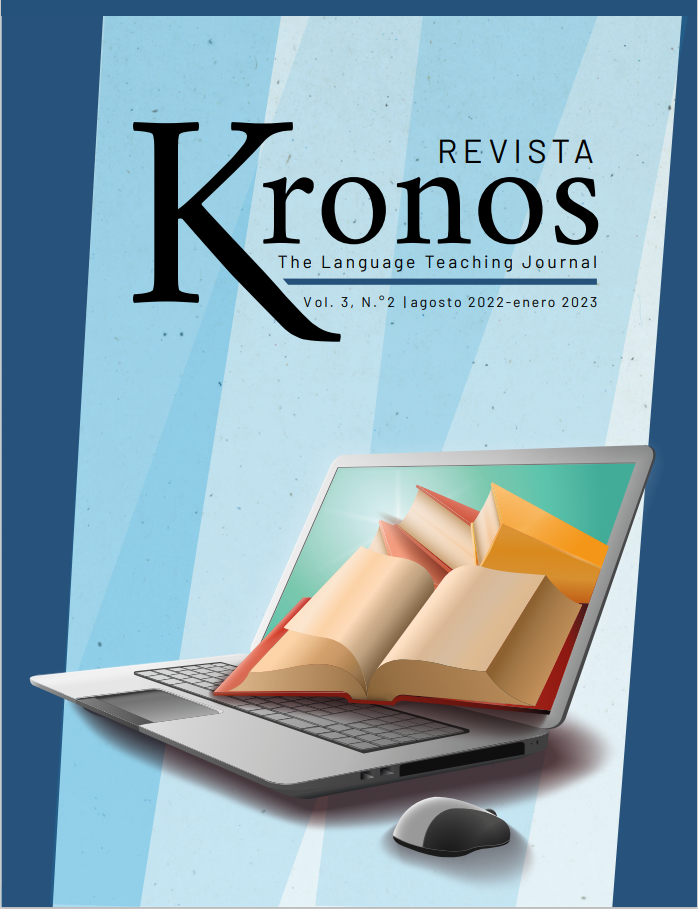Factors that prevent the English oral production of students of first and second year of bachillerato
DOI:
https://doi.org/10.29166/kronos.v3i2.3829Keywords:
English language, oral production, limitations, factors, motivationAbstract
English has become the universal communication language of business, tourism, education, technology, and science. Developing students' oral skills in the classroom has become a great challenge for English teachers since there are limitations to producing the target language. Therefore, the main purpose of this study was to identify the factors
that prevent the English oral production of students of first and second year of bachillerato. This research used a quantitative approach where a survey and an observation guide for students and teachers were applied to collect the data in[1]formation. The population of this study was 34 students and a teacher. The main results showed that learners cannot
produce speaking skills because they are afraid of making mistakes in their oral presentations and they consider that English is difficult to pronounce. Additionally, the negative affective factors such as anxiety, pressure, nervousness, and apprehension influenced directly in their oral performance. These hindrances that learners face daily in the classroom can be diminished through constant motivation and confidence. Hence, it is advisable the frequent use of interesting and dynamic activities that promote communication in real situations and in that way to accomplish the academic goal
which is to enhance students’ oral proficiency.
Downloads
References
Adwani, P., & Shrivastava, S. (2017). Analysis of factors affecting second language acquisition. International Journal of Social Sciences and Management, 4(3), 158-164.
Ahmad, S. R. (2016). Importance of English communication skills. International Journal of Applied Research, 2(3), 478-480.
Akhter, S., Haidov, R., Rana, A. M., & Qureshi, A. H. (2020). Exploring the significance of speaking skill for EFL learners. PalArch's Journal of Archaeology of Egypt/Egyptology, 17(9), 6019-6030.
Ansari, M. S. (2015). Speaking anxiety in ESL/EFL classrooms: A holistic approach and practical study. International Journal of Education Investigation, 2(4), 38-46.
Arnold, J. (2003). Speak easy: How to ease students into oral production. Humanising Language Teaching, 5(2), 1-13.
Benalcázar-Bermeo, J., & Ortega-Auquilla, D. (2019). Effects of the CLIL approach in oral production of english students in the second year of the united general baccalaureate at a high school in Cuenca, Ecuador. Revista Boletín Redipe, 8(12), 117-128.
Bhattacharjee, N. (2008). Developing speaking skill at secondary and higher secondary levels: problems and few recommendations. Stamford Journal of English, 4, 15-29.
Clement, A., & Murugavel, T. (2018). English for the workplace: The importance of English language skills for effective performance. The English Classroom, 20(1), 1-15.
Dilnoza, K. (2021). DEVELOPING SPEAKING SKILLS OF ESL AND EFL STUDENTS. Web of Scientist: International Scientific Research Journal, 2(09), 116-119.
Dincer, A., & Dariyemez, T. (2020). Proficient Speakers of English as a Foreign Language: A Focus-Group Study. IAFOR Journal of Education, 8(1), 83-99.
Elahifar, M. (2022). Effect of hot Seat technique on pre-intermediate learners' oral production. Journal of new advances in English Language Teaching and Applied Linguistics, 4(1), 739-752.
ESCUDERO, G. I., CUTIOPALA, D. J., & CAISAGUANO, J. A. (2020). A comprehensible overview of EFL students’ drawbacks to produce oral communication. Revista Espacios, 41(18).
Han, L., & Yusof, M. A. M. (2019). Students’ self-reflections of own participation in English language oral class. LSP International Journal, 6(2).
Jiménez, G. V. (2015). Three communication difficulties of EFL students. Revista de Lenguas Modernas, (23).
Khoirunisya’Masyhudianti, U., & Masithoh, H. (2018). A Teacher’s Beliefs and Practices of Using Video to Teach Speaking: A Case Study At SMA As-Salam Surakarta. Vision: Journal for Language and Foreign Language Learning, 7(1), 11-22.
Leong, L. M., & Ahmadi, S. M. (2017). AN ANALYSIS OF FACTORS INFLUENCING LEARNERS’ENGLISH SPEAKING SKILL.
Manrique, C. M. R. (2013). Mother Tongue Interference over Foreign Language: A Case Study about A2 Oral Production in a Colombian Public University. Opening Writing Doors Journal, 9(1), 91-119.
Published
How to Cite
Issue
Section
License
Copyright (c) 2022 Vinicio Bermello García, Mónica Vaca-Cárdenas

This work is licensed under a Creative Commons Attribution-NonCommercial-ShareAlike 4.0 International License.












